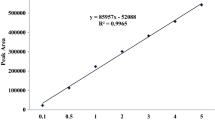Abstract
With the widespread use of mesotrione, its residues have become increasingly serious and caused a series of environmental problems in northern China. To reduce the harm of these residues, we investigated the degradation effect of mesotrione in typical soils in northern China at different temperatures, soil moisture, pH values and initial concentrations. We also examined the influence of soil type, microorganisms and the use of organic matter and biogas slurry as soil amendments. Mesotrione degradation rates increased as the temperature, soil moisture, soil pH and the content of biogas slurry increased; and decreased as the organic content and the initial concentration of mesotrione increased. The degradation rates were different in the three soils. Microorganisms played an important role in the degradation process. These result may offer a theoretical basis for decreasing mesotrione residue when using this product in northern China.



Similar content being viewed by others
References
Ali M, Kazmi AA, Ahmed N (2014) Study on effects of temperature, moisture and pH in degradation and degradation kinetics of aldrin, endosulfan, lindane pesticides during full-scale continuous rotary drum composting. Chemosphere 102:68–75
Batisson I, Crouzet O, Besse-Hoggan P, Sancelme M, Mangot JF, Mallet C (2009) Isolation and characterization of mesotrione-degrading Bacillus sp. from soil. Environ Pollut 157:1195–1201
Beaudegnies R, Edmunds AJF, Fraser TEM, Hall RG, Hawkes TR, Mitchell G, Schaetzer J, Wendeborn S, Wibley J (2009) Herbicidal 4-hydroxyphenyl-pyruvate dioxygenase inhibitors—a review of the triketone chemistry story from a Syngenta perspective. Bioorg Med Chem 17(12):4134–4152
Bonnet JL, BonnemoY F, Dusser M, Bohatier J (2008) Toxicity assessment of the herbicides sulcotrione and mesotrione toward two reference environmental microorganisms: tetrahyrnena pyriformis and Vibrio fischeri. Arch Environ Contam Toxicol 55:576–583
Chen XX, Li WM, Wu Q, Chen WT, Han LJ (2012) Dissipation and residues of the herbicidemesotrione in maize and soil in open field. Bull Environ Contam Toxicol 5:772–775
Chen TM, Yin CT, Hu YB (2014) Adsorption of mesotrione in soil: kinetic and thermodynamic parameters. Fresen Environ Bull 16(4):472–476
Durand S, Amato P, Sancelme M, Delort AM, Combourieu B, Besse-Hogan P (2006) First isolation and characterization of a bacterial strain that biotransforms the herbicide mesotrione. Lett Appl Microbiol 43(2):222–228
Durand S, Sancelme M, Besse-Hoggan P, Combourieu B (2010) Biodegradation pathway of mesotrione: complementarities of NMR, LC-NMR and LC-MS for qualitative and quantitative metabolic profiling. Chemosphere 81(3):372–380
Dyson JS, Beulke S, Brown CD, Lane MCG (2002) Adsorption and degradation of the weak acid mesotrione in soil and environmental fate implications. J Environ Qual 31(2):613–618
Felix J, Doohana DJ, Bruins D (2007) Differential vegetable crop responses to mesotrione soil residues a year after application. Crop Prot 26(9):1395–1403
Halle AT, Richard C (2006) Simulated solar light irradiation of mesotrione in natural waters. Environ Sci Technol 40(12):3842–3847
Kadian N, Gupta A, Satya S, Mehta RK, Malik A (2008) Biodegradation of herbicide (atrazine) in contaminated soil using various bioprocessed materials. Bioresour Technol 11:4642–4647
Krauss M, Wilcke W (2002) Sorption strength of persistent organic pollutants in particle-size fractions of urban soils. Soil Sci Soc Am J 66:430–437
Mathava K, Ligy P (2006) Adsorption and desorption characteristics of hydrophobic pesticide endosulfan in four Indian soils. Chemosphere 62(7):1064–1077
Muñoz-Leoz B, Garbisu C, Charcosset J-Y, Sanchez-Perez JM, Antiguedad I, Ruiz-Romera E (2013) Non-target effects of three formulated pesticides on microbially mediated processes in a clay-loam soil. Sci Total Environ 449:345–354
Quan GX, Yin CT, Chen TM, Yan JL (2015) Degradation of herbicide mesotrione in three soils with differing physicochemical properties from China. J Environ Qual 5:1631–1637
Richard C, Halle AT, Brahmia O, Malouki M, Halladja S (2007) Auto-remediation of surface waters by solar-light: photolysis of 1-Naphthol and two herbicides in pure and synthetic waters. Catal Today 124(3/4):82–87
Rouchaud J, Neus O, Cools K, Bulcke R (2000) Dissipation of the triketone mesotrione herbicide in the soil of corn crops grown on different soil types. Toxicol Environ Chem 77(1–2):31–40
Spark KM, Swift RS (2002) Effect of soil composition and dissolved organic matter on pesticide sorption. Sci Total Environ 298(1/3):147–161
Tang MZ, Guo ZY (2010) Degradation of thifensulfuron in brown earth. J Ecol Rural Environ 26(2):185–188
Yao B (2003) Degradation of herbicides in soil and their effect on biological indicators for soil quality. Dissertation, College of Environmental Science and Resources of Zhejiang University
Zhang DH, Teng GS, Li ZQ (2012) Determination of mesotrione in food by liquid chromatography tandem mass spectrometry. Anal Chem 5:811–812
Acknowledgements
The study was supported by the Special Fund for Agro-scientific Research in the Public Interest (201203098), Science and Technology Project of Henan Province (162102110004 and 152102110141). We are grateful to the anonymous reviewers for their valuable comments and suggestions.
Author information
Authors and Affiliations
Corresponding authors
Rights and permissions
About this article
Cite this article
Su, W., Hao, H., Wu, R. et al. Degradation of Mesotrione Affected by Environmental Conditions. Bull Environ Contam Toxicol 98, 212–217 (2017). https://doi.org/10.1007/s00128-016-1970-9
Received:
Accepted:
Published:
Issue Date:
DOI: https://doi.org/10.1007/s00128-016-1970-9




